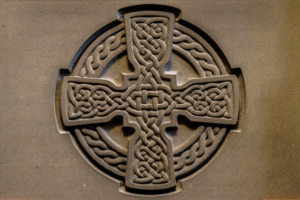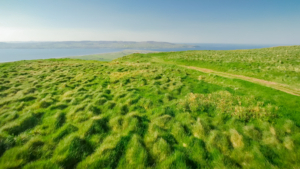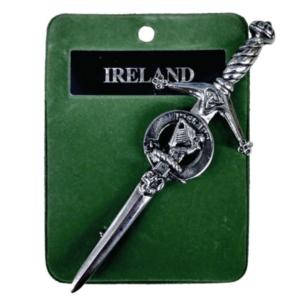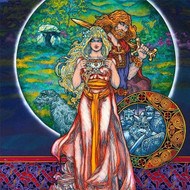Irish Mythology 101
Posted by The Celtic Croft on Apr 3rd 2020
Ireland is a nation that has long been associated with thrilling legends, mysterious myths, and tantalizing traditions. This is a land of legend, mystery, and intrigue, and Irish folklore is passed down through the generations, tales becoming lost in the mists of time.
These stories have been handed through history, often solely through the power of speech, and they have taken root in our consciousness to become an accepted part of the fabric of Ireland. Behind every historic site, there is a story, every man there is a myth, and every home just a hint of magic. In a world where the truth and history become woven together and indistinguishable, the power of the tale is just as relevant today.
From kilts to clans, here is everything you need to know about the roots of Irish mythology. Read on for the ultimate guide to the long-lost lore!

The Mythological Cycle
A look at Irish mythology starts at the beginning - or at least that which we know to be the beginning - the Mythological Cycle. This cycle introduces the first era of Irish folklore, and the long-ago age means that many of the facts are lost to time. Documentation is sparse, and much of what we can learn has been handed down verbally.
There are seven groups found in these tales, and these seem pretty standard features. The core seven include:
- Cessair
The narrative tells us that Cessair, or Cesair, was the leader of the very first settlers in Ireland. She plays a starring role in the Lebor Gabála Érenn - the ancient medieval text.
- Fomorians
The Fomorians are a supernatural race, said to be dark and hostile. They are depicted visually as large, monster-like creatures, and were said to dwell underground, or underwater.
- Partholinians
The Partholinians were said to have followed Cessair’s group and were responsible for building, farming, cooking, and other traditional activities.
- Nemedians
Arriving 30 years after the Partholinianas, these settlers were short-lived. Their brevity has not prevented their stories from being handed down in Irish mythology, however.
- Firbolgs
This group descended from the Muintir Nemid, who later moved on to inhabit Europe, and were the fourth group of settlers.
- Milesians
As the final group to settle, these are the groups considered to represent the people of Ireland. Their arrival coincided with the Tuatha Dé Danann, who embodied paganism on the island.
- Tuatha Dé Danann
Mysterious supernatural beings, the Tuatha Dé Danann, were said to be the representation of the pagan gods in a wild, pre-Christian Ireland.

The Ulster Cycle
The Ulster Cycle represents the second cycle, and most stories come from the 1st century AD. Most of the tales in this circle are set in Connacht and Ulster. Birth and death are the primary themes, along with training, epic battles, and countryside living. Kings and queens, heroes and gods, foes and enemies all take center stage. Some of the most famous tales include:
- Táin Bó Cúailnge
A war is waged between Ulster and Connaught, and Queen Medb enters battle alongside her husband, Ailill.
- The Death of Aife’s Son
A tragic tale of love, loss, and family; this is the story of CuChulainn, who leaves his pregnant wife to tackle a heroic battle.
- Destruction of Da Derga’s Hostel
Conaire Mór, King of Ireland, weaves a tale of death and destruction, birth and loss. Celebrations, triumphs, and defeats are woven together in a tale of royal bravery.
- Bricriu’s Feast
This is an 8th-century tale of warriors, heroes, and battles. It pulls rank as one of the most famous and popular tales in Irish mythology, and in many ways personifies the themes and style of the Ulster Cycle.
The Fenian Cycle
The Fenian Cycle takes us south, to the regions of Munster and Leinster, and the stories consist of heroes slaying monsters, and heroines taking charge. The Fianna are the focus here; these are a fierce band of independent warriors, lead by the mighty Fionn Mac Cumhaill. Some of the major tales from this cycle include:
- Acallam na Senórach
One of the most famous texts from the Fenian Cycle, the Acallam na Senórach, tracks the story of Saint Patrick versus the fearsome Fianna tribe.
- Tóraigheacht Dhiarmada agus Ghráinne
Love triangles are a story as old as time, and this is the tale of Fionn Mac Cumh, the princess Grainne, adorned with jewels and royal finery, and Diarmuid Ua Duibhne, the infamous lover.
- Tír na nÓg
No mythological series is complete without a fairyland, and Tír na nÓg fits this quota. A supernatural realm, this is a fantasy world of everlasting youth and beauty, and incredible stories are woven together with magical horses traveling on water, lovers united, and incredible wonder and magic.

The Historical Cycle
The final cycle of mythology, the Historical Cycle blends real stories with myths and legends; one is never entirely sure what is real and what is a beautiful story. Genuine history nestles alongside fantastic creatures, and authentic, physical figures go toe to toe with dragons and wondrous creatures.
Buile Suibhne is the most famous story from this cycle. The 12th-century take is a fluid combination of prose and verse and contains supernatural powers, terrifying curses, and mysterious miracles, which combine mysticism and magic with an almost-true tale.

The Magic of Mythology
Irish mythology is an incredible journey, which takes us from the earliest days of documentation, blurring the line between fiction and history with stunning flair and sleight of hand.
Like so much of Ireland, there is a real sense of magic in every line - the idea that everything you are reading could have happened right here on this island. Heroes battle dragons, rulers ride into battle, brides choose their beloveds, and extravagant feasts are held; and all brought to life by the fantastic power of the word.
Speaking of weddings, check out our list of Irish wedding traditions here.
The Celtic tradition is one that has captured the imagination of writers, artists, and creators for thousands of years, and it is not difficult to see why. Though the details and locations of the tales may have changed throughout history, one theme remains constant; they are all set against the beautiful background of the island of Ireland and contain that thread of wonder and intrigue. The idea that something is hiding just beyond a veil of mist, hanging, like a curtain waiting to be unveiled, is that unique magic which is so symbolic of Ireland.

